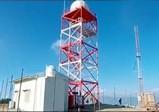India to have 126 doppler radars by 2026 as govt ramps up weather monitoring
By IANS | Updated: April 26, 2025 09:37 IST2025-04-26T09:31:53+5:302025-04-26T09:37:19+5:30
New Delhi, April 26 The Doppler Weather Radar network is set to rise from the current 37 operational ...

India to have 126 doppler radars by 2026 as govt ramps up weather monitoring
New Delhi, April 26 The Doppler Weather Radar network is set to rise from the current 37 operational radars to 73 by 2025-26, and further to 126 by 2026, the government has said.
The new installations are being planned in high-priority regions such as Bengaluru, Raipur, Ahmedabad, Ranchi, Guwahati and Port Blair, among others.
It was announced during a high-level meeting of India Meteorological Department (IMD) and key ministries, chaired by Union Minister Dr Jitendra Singh, to review India's weather and disaster preparedness, and roll out roadmap for accurate forecast.
The minister called for expediting expansion of Doppler Weather Radar (DWR) coverage and modernisation of meteorological systems across the country.
At present, Delhi has 18 Automatic Weather Stations (AWS) in operation. During the review, the Minister directed officials to expedite the installation of 50 additional systems, with a long-term goal of scaling up to 100 AWS.
This move aims to bring Delhi’s weather forecasting infrastructure on par with global standards. These automated systems are designed to deliver highly specific, accurate, and timely forecasts, significantly enhancing the city’s capacity to monitor and respond to changing weather conditions.
Amidst the growing frequency of extreme weather events, Dr Singh emphasised the urgent need for real-time, impact-based forecasting that can help minimise damage and save lives.
“No weather hazard should go undetected or unpredicted,” the Minister asserted, underscoring the government’s resolve to build a resilient early warning system that reaches every corner of the country.
The minister was briefed on the selection of radar sites and the overall progress of the “Mission Mausam” launched by PM Narendra Modi, which aims to revolutionise India’s weather monitoring infrastructure. The plan includes improved satellite meteorology systems, upgraded numerical prediction models, and a more robust radar-based forecasting mechanism.
“The ability to track extreme weather events with greater precision will not only boost disaster management efforts but also directly benefit farmers, fishermen, aviation, and various other sectors,” Dr Singh noted during the meeting.
Disclaimer: This post has been auto-published from an agency feed without any modifications to the text and has not been reviewed by an editor
Open in app